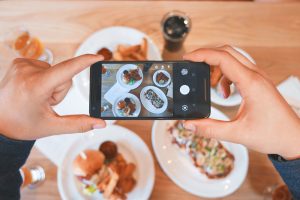 A brand new decade is upon us—along with new budgets and glorious new bottomless pits to throw a marketing budget into. The marketing approaches we used in the last decade are all but worthless moving into the new 20’s.
A brand new decade is upon us—along with new budgets and glorious new bottomless pits to throw a marketing budget into. The marketing approaches we used in the last decade are all but worthless moving into the new 20’s.
Today’s world is more visual than ever. Our new reality is full of people sitting in silence inside big rooms all simultaneously staring into their phones like a bunch of well-trained zombies. The three-second attention span has taken our world by storm. Fighting for a slice of that brief attention will be more competitive and cutthroat than ever before in history.
In my new book, Restaurant & Bar Marketing II: Hacking Human Nature, I mention how your online presence is a lot like a Tinder profile. You have three seconds to “score” a visit from that new customer—a customer who has endless possibilities and an endless parade of your competition vying for the same attention. In this environment, looks are everything. You can’t just have the best food and service anymore, you have to bring them in the door with great aesthetics and your most attractive possible version of yourself.
Your regulars know your food and service are awesome, but what about the customer who doesn’t yet know you exist? What about the tourist and the guy on the other end of Google? Loyal customers are great, but expanding business is about expanding your reach and showing your awesome aesthetic to a continuously new group of people who have not yet heard about you. People who definitely don’t follow you on social media. After all, you can’t follow a business you don’t know exists.
I published a prediction a few years ago that said websites will become obsolete by 2020. We’re not far off from this now. Google is all we need. The Google Knowledge Panel is that window that shows up toward the right of your screen (on a computer) or top dead center on a mobile search. This area provides everything you’ll ever want to know about any particular business: Their contact info, address, hours, reviews, and every other reason you’d Google a place are all present. Especially, you guessed it, photos. But instead of the glossy professional photo shoot we’d like the public to see, mixed in are photos from the public—a public who generally can’t take a great photo to save their lives. Although Joe Customer’s photos don’t look all that great, they are way more authentic than the stuff we provide. Authenticity is what sells moving into 2020 and beyond.
So yes, a professional photo shoot and an impressive aesthetic could bring them in the door the first time, no question. If your place is a sad rendition of the experience you’re portraying to the public, they’ll all be one-and-done visitors. What your place actually looks like is of paramount importance, not just the attractive lure you provide to the online public. You’ve heard the term “people eat with their eyes.” Now they also make almost every other decision in life with their eyes as well since they are glued to that screen as many hours as humanly possible.
So now that we realize we have to be attractive, where do we go to “get some action?” Social media used to be the knee-jerk reaction to that question, but as the years go by, both Facebook and Instagram are becoming less and less effective as marketing tools. This is partially due to the algorithm choking down our reach to near zero, and partially because our content, for the most part, is just awful. If you have a beautiful looking place and a truly unique presentation, your customers may actually take on this role for you—all for free and all on their own unrestricted pages full of a new audience and a potentially limitless reach.
Services like Localfluence have taken full advantage of this and actually send Instagram users into your place with the agreement that for a discounted meal, they will post an awesome pic of your place to their own account. It’s kind of a “word of mouth” in air-quotes approach, but it actually works pretty well. If you show them how cool your place is, you’re advertising. If they show their friends how cool your place is, they’re bragging on your behalf. Guess which one is more effective?
So what about the aforementioned tourist and the people that are unfamiliar with the area? Chances are everything social media based will be irrelevant. There are some social media ad-targeting techniques out there that are pretty successful, but when we’re all in unfamiliar territory and get hungry, we pull out that computer in our pockets (if it’s not already in our hand) and our three go-to tools are Google, Yelp, and TripAdvisor.
Your online reviews have a bigger influence than you may think. More importantly, where you rank on Google makes the biggest impact possible. Human nature doesn’t dictate that we scroll to page five of Google, or even page two in most cases. We use the map and look for the best choices within the closest distance. When a place sparks our interest, we tend to do quick research through Google pictures, then a possible search on Facebook or Instagram for more. Then the decision is made. Tourists find us on Google, Yelp, or TripAdvisor and research us on social media.
After the importance of aesthetics comes attitude. A great look brings them in the door, but a great attitude brings them back in. This sounds like common sense but seems to be lost in today’s service industry. Now that online reviews hold so much weight, poor experiences can easily be multiplied. A poor online review can statistically cost you 30 customers! We can say, “I don’t care what Yelpers think,” all day, but (unfortunately?) the public does care. A lot.
If operations aren’t firing on all cylinders, marketing could quite possibly hurt instead of help. If our consumer experience sucks, marketing will help people learn that we suck, only quicker.
Technology will move faster than ever in the new 20’s. Marketing techniques will have a shorter shelf life due to the ever-decreasing attention span of today’s human. Be attractive. Be entertaining. Give consumers a reason to bring up the experience they had at your business while discussing their weekend. After all, the marketing power of a friend or coworker will trump anything we can do as professional marketers. Word of mouth has always been king and always will be.
As a “marketing expert,” I’m here to tell you that the power of marketing is slowly losing its effectiveness. Advertising will steadily lose ground and instead be replaced by entertainment. I’ve said it several times in the past—”Be the show, not the commercial.”
The good news here is that creativity is free. Instead of posting 30 pictures of a burger per month, come up with one great, creative, hilarious, relevant video clip per month. This will far outweigh the effectiveness of humdrum social media posts, and in most cases, will be a lot cheaper to produce. Ask yourself what you respond to as a consumer and create more of that. Today’s restaurant and bar owners are bombarded with more BS than ever before by “marketing experts,” which is tough to wade through. Always ask yourself if you as a consumer would use the tools they’re slinging. If it sounds like garbage, it probably is.
By Erik Shellenberger, who has been in the restaurant and bar industry since he was thirteen years old and worked for his mother in the food and beverage department at a Utah ski resort. Since then, he has held every position from dishwasher to bartender to marketing director and everything in between. With a decade of corporate marketing experience, he has gone from student to teacher and now runs Bar Marketing Basics (barmarketingbasics.com). He has quickly grown his client base, expanding beyond his hometown of Scottsdale, Arizona, into Los Angeles, California and has connected with clients across the nation, as far away as the East Coast. For more on bar marketing, check out Erik’s latest book, Restaurant & Bar Marketing II: Hacking Human Nature available on Amazon.








